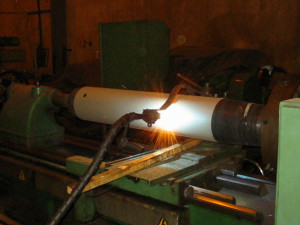19
May 2017
What are the benefits of Thermal spray Coatings in metal processing plants
by alloy
Various components in metal processing units are exposed to rigorous wear and corrosion that can be protected by thermal spray coatings to maintain their service. The main components that can be secured by thermal spray are configured in electric arc furnace, oxygen furnace, molds, casting dies, casting salvage, molten metal containment, steel mill rolls in wet and dry mill entrance and exit ways of steel processing path, galvanized and aluminized steel sheets.
- A great range of components used in electric arc furnace and basic oxygen furnace are exposed to vigorous corrosion by heat, particulate and acidic media. Water quenched in off gas duct systems for example pans, roofs, boxes and panels are exposed to high velocity combustion gases that comprise of corrosive chemicals that condense and attack the heat transfer surfaces. Coatings are developed for resistance to wear and corrosion at high temperature.
- In castings the cast component in the lower side of the mold wears the mold’s bottom. The combination of copper substrate into the surface of the cast results into star cracking. Nickel based coatings secure copper from wear and also improve caster product quality by widely reducing cast product contamination and star cracking issues. Thermal barrier coatings control the heat transfer and reduce quick cooling. For vigorously corrosive melts, pure yttria is used. They are accumulated on the metal bond coat. Multi layer coatings by thermal spray wire offers a good balance between coefficient of expansions of mold and topcoat.
Casting salvage is also obtained by filling the voids of porosity or wear regions after grinding through arc wire sprayed coatings which are then remachined.
- Hot dipping rolls- An advanced thermal spraying material is used for aluminum die casting components and for hot regular dipping rolls. Undercoat prevents the effect of wide difference between thermal expansion of topcoat and stainless steel substrate, commonly used for hot continuous dipping. The evaluation of durability of Nickel-Chromium and Cobalt – Molybdenum – Chromium coatings in the same condition showed that these types of coatings offer high soldering resistance.
- Arc sprayed steel tooling is used to develop matched die sets for injection molding applications
- Tungsten carbide coatings are utilized on bridle and accumulator rolls in the entrance and exit points of a steel treatment line, they prevent the cracking of roll surface, offer suitable grip and offer anti-skid properties.
- Galvanized and aluminized steel sheets demand excellent surface quality, specifically in exposed panels. In regular galvanizing and aluminizing, the steel strip is dipped in the molten bath through a series of rolls that control the speed and tension of the strip and evaluate the steel strip across the molten metal bath. The rolls serving in the molten zinc-aluminum alloy are exposed to extremely corrosive media and need rapid replacement and repair. Coating smoothens the sink and stabilizer rolls and develops better strip surface.


